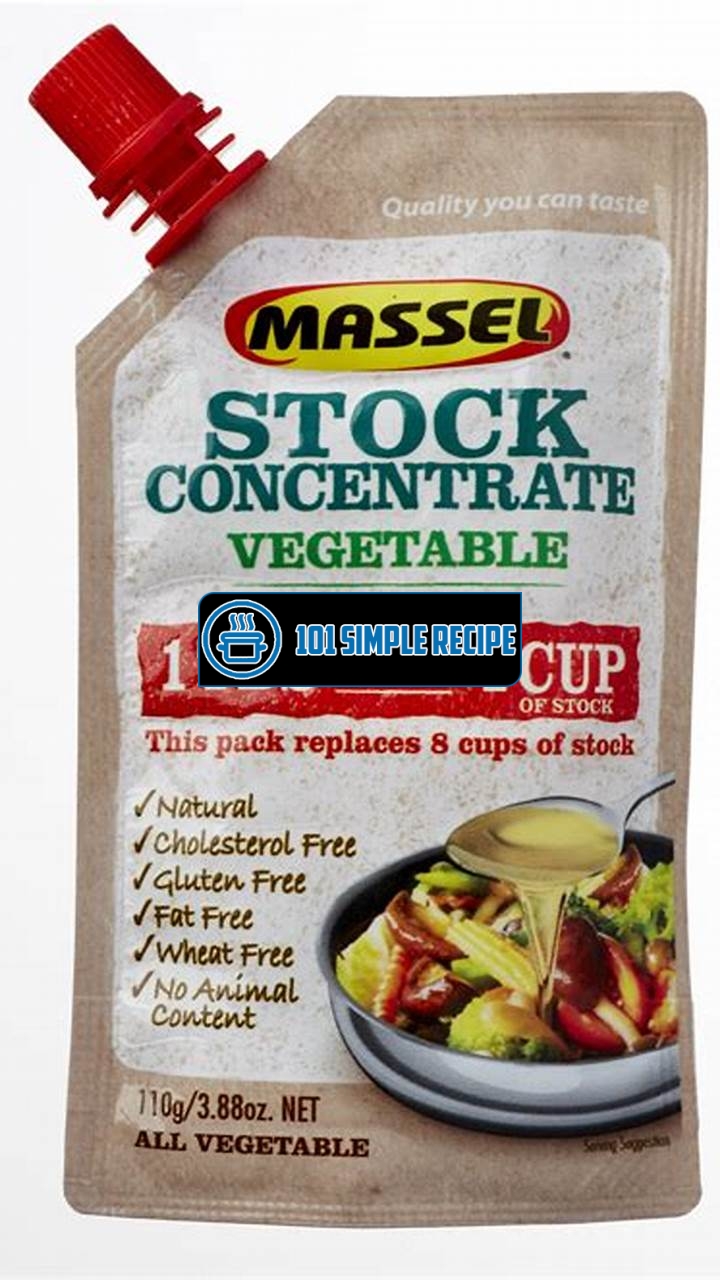Are you ready to elevate your cooking game to the next level? In this article, you will learn how to master the art of making delicious vegetable stock concentrate. A versatile ingredient that adds depth and flavor to a wide range of dishes, vegetable stock concentrate is a must-have in any kitchen. Whether you’re a vegetarian, vegan, or just looking to add more plant-based options to your diet, this homemade concentrate will become your secret weapon in creating mouthwatering meals. So grab your apron and let’s dive into the wonderful world of vegetable stock concentrate!

Understanding Vegetable Stock Concentrate
When it comes to adding depth and richness to the flavors of your dishes, vegetable stock concentrate is a versatile ingredient that you should have in your kitchen arsenal. This concentrated form of vegetable stock is made by simmering vegetables, herbs, and spices until their flavors meld together into a concentrated liquid. The result is a flavorful and aromatic base that can be used to enhance the taste of a wide range of dishes. Whether you’re making soups, stews, sauces, or risottos, vegetable stock concentrate can take your culinary creations to the next level.
What is Vegetable Stock Concentrate
Vegetable stock concentrate is a highly concentrated liquid made by simmering a variety of vegetables, herbs, and spices in water. The vegetables used can include onions, carrots, celery, garlic, leeks, mushrooms, and herbs such as thyme, parsley, and bay leaves. These ingredients are simmered together for a period of time, typically several hours, until the flavors are fully extracted and concentrated. The resulting liquid is then strained, and the solids are discarded, leaving behind a concentrated vegetable stock that can be stored and used as needed.
Benefits of Using Vegetable Stock Concentrate
- Enhanced Flavor: Vegetable stock concentrate adds a depth of flavor to your dishes that can elevate them from ordinary to extraordinary. The concentrated flavors of the vegetables, herbs, and spices infuse the dish, giving it a rich and savory taste.
- Versatility: Vegetable stock concentrate is a versatile ingredient that can be used in a wide range of recipes. It can be added to soups, stews, sauces, gravies, pasta dishes, and risottos to enhance their flavors and provide a savory base.
- Convenience: Having vegetable stock concentrate on hand means that you can easily add flavor to your dishes without the need to make stock from scratch. It saves both time and effort in the kitchen.
- Long Shelf Life: Vegetable stock concentrate can be stored in the refrigerator for an extended period of time, allowing you to have it on hand whenever you need it. This makes it a convenient pantry staple.
How to Choose a Good Vegetable Stock Concentrate
When selecting a vegetable stock concentrate, there are a few factors to consider to ensure you choose a high-quality product:
- Ingredients: Look for a vegetable stock concentrate that uses real vegetables, herbs, and spices in its ingredients list. Avoid products that contain artificial flavors or preservatives.
- Salt Content: Some vegetable stock concentrates can be high in sodium. If you’re watching your salt intake, opt for a low-sodium or reduced-sodium version.
- Brand Reputation: It’s always a good idea to look for a reputable brand when choosing a vegetable stock concentrate. Read reviews or ask for recommendations to ensure you’re getting a product that delivers on flavor.
By understanding what vegetable stock concentrate is and its benefits, you can take your culinary skills to new heights. Experiment with different recipes and discover the wonders that vegetable stock concentrate can bring to your dishes. Enjoy the process of creating flavors that make your meals truly memorable!
Making Vegetable Stock Concentrate at Home
Learn the step-by-step process of creating homemade vegetable stock concentrate that is healthier and more cost-effective.
Essential Ingredients for Vegetable Stock Concentrate
When it comes to making vegetable stock concentrate at home, you will need a variety of essential ingredients. These ingredients not only provide the base flavor but also add depth and richness to your stock. Here are the key ingredients you will need:
- Vegetables: Use a combination of aromatic vegetables such as onions, celery, carrots, and garlic. These vegetables contribute to the overall flavor profile of the stock concentrate.
- Herbs and Spices: Enhance the taste of your vegetable stock concentrate by adding herbs and spices like bay leaves, thyme, rosemary, peppercorns, and parsley. These ingredients infuse the stock with delicious flavors.
- Salt: A small amount of salt helps to bring out the flavors in the vegetables and herbs. However, be careful not to add too much salt as you can always adjust the seasoning later while using the stock concentrate in your recipes.
- Water: The base of any stock concentrate is water. Make sure to use clean, filtered water for the best results.
By using fresh and high-quality ingredients, you can ensure that your homemade vegetable stock concentrate turns out to be flavorful and nutritious.
Preparation and Storage of Vegetable Stock Concentrate
The process of preparing vegetable stock concentrate is simple and straightforward. Follow these steps:
- Chop the vegetables: Rinse and chop the vegetables into small pieces. This helps to extract maximum flavor during the cooking process.
- Sauté the vegetables: In a large pot, heat some oil and sauté the vegetables until they start to soften and release their aromas. This step further enhances the flavor of the stock concentrate.
- Add herbs, spices, and water: Once the vegetables are sautéed, add the herbs, spices, and water to the pot. Bring it to a boil and then reduce the heat to a simmer.
- Simmer and reduce: Let the mixture simmer for a couple of hours, allowing the flavors to meld together and the liquid to reduce. Stir occasionally to prevent any sticking or burning.
- Strain and cool: After simmering, strain the stock concentrate using a fine mesh sieve or cheesecloth to remove any solids. Let it cool completely before transferring to storage containers.
- Storage: Store the vegetable stock concentrate in airtight containers and refrigerate for up to a week or freeze for longer storage. Freezing the concentrate in ice cube trays allows for convenient portioning when needed.
Remember to label the containers with the date of preparation to keep track of freshness.
Tips for Enhancing the Flavor of Homemade Vegetable Stock Concentrate
To take your homemade vegetable stock concentrate to the next level, here are some tips to enhance its flavor:
- Add roasted vegetables: Roasting certain vegetables like onions, carrots, and garlic before adding them to the stock concentrate can add a deeper, caramelized flavor.
- Use vegetable scraps: Don’t throw away the vegetable scraps you accumulate while cooking. Instead, collect them in a freezer bag and use them to make stock concentrate. Scraps like onion peels, carrot tops, and celery ends can add extra flavor.
- Add umami boosters: Enhance the umami flavor of your vegetable stock concentrate by adding ingredients like dried mushrooms, seaweed, or soy sauce.
- Experiment with different herbs and spices: Feel free to explore different combinations of herbs and spices to customize the flavor of your stock concentrate. From thyme and rosemary to cumin and coriander, the possibilities are endless.
- Reduce the stock further: If you prefer a more concentrated flavor, simmer the stock for a longer time to reduce it even further. This will intensify the flavors and create a richer concentrate.
With these tips, you can elevate the taste of your homemade vegetable stock concentrate and enjoy its versatility in various dishes.
Using Vegetable Stock Concentrate in Cooking
When it comes to enhancing the flavors of your dishes, vegetable stock concentrate is an essential ingredient that can take your cooking to new heights. This powerful and concentrated stock adds a depth of flavor that is hard to achieve with plain water or store-bought liquid stock. In this article, we will explore various ways to incorporate vegetable stock concentrate into your recipes and elevate the taste of your dishes.
Substituting Vegetable Stock Concentrate for Liquid Stock
One of the primary uses of vegetable stock concentrate is as a substitute for liquid stock. Instead of using pre-made liquid stock from a carton or can, you can simply mix vegetable stock concentrate with water to create an instant and flavorful stock. This allows you to customize the intensity of the stock according to your preference, whether you want a milder flavor or a stronger taste. Additionally, using vegetable stock concentrate gives you control over the sodium content of your dishes, as some store-bought liquid stocks can be high in sodium.
Try substituting vegetable stock concentrate in your favorite recipes that call for liquid stock, such as soups, risottos, and casseroles. The concentrated flavor will add an extra level of richness to your dishes.
Enhancing Soups, Stews, and Sauces with Vegetable Stock Concentrate
Soups, stews, and sauces are the perfect canvas for the flavors of vegetable stock concentrate. By adding a spoonful or two of vegetable stock concentrate to these dishes, you can deepen the flavor profile and create a more complex taste. Whether you’re making a hearty vegetable soup or a flavorful tomato sauce, the use of vegetable stock concentrate will elevate your dish to a new level.
Experiment with different combinations of vegetables and herbs to create your own signature stock concentrate. By customizing the flavors, you can tailor the concentrate to complement the specific dishes you love to cook.
Marinating and Seasoning with Vegetable Stock Concentrate
Another fantastic way to utilize vegetable stock concentrate is by using it as a marinade or seasoning for your proteins and vegetables. The concentrated flavors in the stock can infuse your ingredients with a delicious taste, making them more flavorful and succulent. Whether you’re grilling vegetables, marinating chicken, or roasting tofu, vegetable stock concentrate can add a delightful umami flavor to your dishes.
Mix vegetable stock concentrate with olive oil, garlic, and herbs to create a flavorful marinade for grilled vegetables. The concentrated flavors will transform your veggies into a mouthwatering side dish.
In conclusion, vegetable stock concentrate is a versatile ingredient that can greatly enhance the taste and depth of your dishes. By substituting it for liquid stock, using it to enhance soups and sauces, and marinating or seasoning with it, you can take your cooking to the next level. So, next time you’re looking to elevate the flavor of your recipes, don’t forget to incorporate vegetable stock concentrate and unlock a world of delicious possibilities.
Alternative Options for Vegetable Stock Concentrate
There are several alternative ingredients and methods you can use to create flavorful vegetable stock concentrate that caters to specific dietary needs or preferences. Whether you follow a gluten-free or vegan diet, or if you’re watching your sodium or carbohydrate intake, these options will allow you to enjoy a delicious stock concentrate without compromising on taste.
Gluten-Free and Vegan Vegetable Stock Concentrate
If you’re following a gluten-free or vegan diet, there are a few key ingredients you can use to create a flavorful stock concentrate. Opt for gluten-free vegetables like carrots, celery, onions, and mushrooms. These ingredients provide a rich depth of flavor without the need for any gluten-containing additives.
For a vegan stock concentrate, avoid using animal-based ingredients like chicken or beef bouillon cubes. Instead, enhance the flavor with herbs and spices such as bay leaves, thyme, rosemary, and garlic. These ingredients add a savory and aromatic dimension to your stock concentrate.
Remember, when making a gluten-free or vegan vegetable stock concentrate, it’s important to carefully read the labels of any pre-packaged ingredients you use to ensure they don’t contain hidden gluten or animal products.
Low-Sodium and Low-Carb Vegetable Stock Concentrate
If you’re watching your sodium or carbohydrate intake, you can still enjoy a delicious vegetable stock concentrate. One option is to reduce or eliminate the use of high-sodium ingredients like salt or commercially prepared vegetable stocks. Instead, rely on the natural flavors of fresh vegetables and herbs to enhance the taste.
To add depth of flavor without the sodium, consider incorporating ingredients such as dried mushrooms, kombu seaweed, or nutritional yeast. These ingredients provide a rich umami taste, making your stock concentrate flavorful without the need for excess salt.
For those on a low-carb diet, it’s important to be mindful of vegetable choices. Opt for lower-carb options like leafy greens, zucchini, broccoli, and bell peppers. Avoid starchy vegetables like potatoes or carrots, as they contain higher levels of carbohydrates.
Keep in mind that if you’re following a restricted diet, it’s always a good idea to consult with a healthcare professional or nutritionist to ensure you’re meeting your specific dietary needs.
Experimenting with Different Vegetable Combinations for Stock Concentrate
The beauty of making your own vegetable stock concentrate is that you have the freedom to experiment with different combinations of vegetables to suit your taste preferences. While traditional stock concentrates often rely on carrots, celery, and onions as the base, don’t be afraid to get creative and try new combinations.
Consider adding vegetables like leeks, fennel, parsnips, or bell peppers to bring unique flavors to your stock concentrate. You can also experiment with different ratios of vegetables to create a balance that appeals to your taste buds.
Remember, the key to achieving the perfect vegetable stock concentrate is to simmer the ingredients for an extended period. This allows the flavors to develop and intensify, resulting in a rich and flavorful concentrate that can elevate your culinary creations.
In conclusion, by exploring alternative options for vegetable stock concentrate, you can cater to various dietary needs or preferences while still enjoying a delicious and flavorful base for your culinary creations. Whether you’re following a gluten-free, vegan, low-sodium, or low-carb diet, there are plenty of ingredients and methods available to create a stock concentrate that suits your needs. Experiment with different vegetable combinations to find the perfect balance of flavors, and remember to simmer your ingredients for optimal taste. Happy cooking!
Recipes Using Vegetable Stock Concentrate
Explore a variety of delicious recipes that showcase the versatility and taste-enhancing abilities of vegetable stock concentrate. From comforting soups to flavorful rice dishes, there are endless possibilities to elevate your cooking with this homemade ingredient.
Vegan Butternut Squash Soup with Vegetable Stock Concentrate
Indulge in the creamy and flavorful vegan butternut squash soup made with vegetable stock concentrate. This hearty soup is a perfect choice for colder weather or as a light meal any time of the year. The vegetable stock concentrate adds depth and richness to the soup, enhancing the natural sweetness of the butternut squash.
To make this delightful soup, you’ll need to gather the following ingredients:
- 1 medium-sized butternut squash
- 2 tablespoons olive oil
- 1 onion, chopped
- 2 cloves of garlic, minced
- 4 cups vegetable broth (made using the vegetable stock concentrate)
- 1 teaspoon dried thyme
- Salt and pepper to taste
Begin by preheating your oven to 400°F (200°C). Cut the butternut squash in half lengthwise and scoop out the seeds. Brush the cut sides with olive oil and place the squash halves, cut side down, on a baking sheet. Roast them in the oven for about 40-45 minutes, or until the flesh is tender.
In a large pot, heat the remaining olive oil over medium heat. Add the chopped onion and minced garlic, and sauté until they become translucent. Then, scoop out the roasted butternut squash flesh and add it to the pot.
Add the vegetable broth, dried thyme, salt, and pepper to the pot. Bring the mixture to a boil, then reduce the heat and let it simmer for about 15 minutes to allow the flavors to meld together.
Once the soup has simmered, use an immersion blender or regular blender to puree the mixture until smooth. For added creaminess, you can stir in a splash of coconut milk or almond milk.
Serve the vegan butternut squash soup hot, garnished with a sprinkle of fresh thyme or a drizzle of olive oil. It pairs well with crusty bread or a side salad for a complete and satisfying meal.
Roasted Vegetable Risotto with Homemade Vegetable Stock Concentrate
Take your risotto game to the next level with this delicious and satisfying roasted vegetable risotto. The homemade vegetable stock concentrate elevates the flavors of the roasted vegetables and infuses the rice with rich taste.
To make this flavorful dish, you’ll need the following ingredients:
- 1 cup Arborio rice
- 2 cups vegetable broth (made using the vegetable stock concentrate)
- 1 onion, finely chopped
- 2 cloves of garlic, minced
- 1 medium-sized zucchini, diced
- 1 red bell pepper, diced
- 1 cup mushrooms, sliced
- 1 tablespoon olive oil
- 1/4 cup grated parmesan cheese
- Fresh basil leaves for garnish
Start by preheating your oven to 425°F (220°C). Toss the diced zucchini, red bell pepper, and sliced mushrooms in olive oil. Spread them out on a baking sheet and roast in the oven for about 20 minutes, or until they become tender and slightly charred.
In a separate pot, heat the vegetable broth over low heat. Keep it warm throughout the cooking process.
In a large saucepan, heat the olive oil over medium heat. Add the chopped onion and minced garlic, sautéing until they become fragrant and translucent.
Add the Arborio rice to the saucepan and toast it for a couple of minutes, stirring constantly to prevent it from sticking. This step helps to enhance the nutty flavor of the rice.
Start adding the warm vegetable broth to the rice mixture, about a ladleful at a time. Stir continuously and allow the rice to absorb the broth before adding more. This slow and steady process helps to achieve the creamy and tender consistency of the risotto.
Once the rice is almost cooked, stir in the roasted vegetables and continue adding the vegetable broth until the rice reaches the desired tenderness. This should take about 20-25 minutes in total.
Remove the risotto from heat and stir in the grated parmesan cheese. Serve the roasted vegetable risotto hot, garnished with fresh basil leaves for an extra burst of flavor.
One-Pot Mediterranean Quinoa with Flavorful Stock Concentrate
For a wholesome and nutritious meal, try this one-pot Mediterranean quinoa dish made with flavorful vegetable stock concentrate. Packed with protein and an array of Mediterranean flavors, it’s an excellent option for a quick and healthy weeknight dinner.
Here’s what you’ll need to make this satisfying quinoa dish:
- 1 cup quinoa, rinsed
- 2 cups vegetable broth (made using the vegetable stock concentrate)
- 1 tablespoon olive oil
- 1 onion, diced
- 2 cloves of garlic, minced
- 1 red bell pepper, diced
- 1 cup cherry tomatoes, halved
- 1/2 cup sliced Kalamata olives
- 1/4 cup crumbled feta cheese
- Fresh parsley leaves for garnish
In a saucepan, heat the olive oil over medium heat. Add the diced onion, minced garlic, and diced red bell pepper. Sauté until the vegetables are softened and the onion becomes translucent.
Stir in the rinsed quinoa and cook for about a minute, allowing it to toast slightly in the oil and vegetable mixture.
Pour in the vegetable broth and bring the mixture to a boil. Once it reaches a boil, reduce the heat to low, cover the saucepan, and let it simmer for 15-20 minutes, or until the quinoa is tender and has absorbed all the liquid.
Remove the saucepan from heat and stir in the halved cherry tomatoes, sliced Kalamata olives, and crumbled feta cheese.
Garnish the Mediterranean quinoa with fresh parsley leaves for a pop of color and herbaceous flavor. Serve it as a main dish or as a side to grilled vegetables or roasted chicken.
These recipes highlight the incredible flavor and versatility of vegetable stock concentrate. Whether you’re a vegan, vegetarian, or simply looking to add more plant-based options to your diet, these dishes are sure to impress your taste buds and elevate your culinary skills. Enjoy experimenting with these recipes and incorporating vegetable stock concentrate into your cooking routine!
Thanks for reading our article on how to make vegetable stock concentrate! We hope you found this guide helpful in creating a flavorful and versatile ingredient for your cooking adventures. Don’t forget to bookmark this page for future reference. Feel free to visit again later when you’re in need of more cooking inspiration!
Frequently Asked Questions
Here are some frequently asked questions about making vegetable stock concentrate:
| No. | Questions | Answers |
|---|---|---|
| 1. | Can I freeze vegetable stock concentrate? | Yes, you can freeze vegetable stock concentrate! It’s a great way to store it for longer periods. Just make sure to use airtight containers or freezer bags to prevent freezer burn. |
| 2. | Is vegetable stock concentrate vegetarian-friendly? | Absolutely! Vegetable stock concentrate is made entirely from plant-based ingredients, making it a perfect choice for vegetarians and vegans. |
| 3. | How long does vegetable stock concentrate last? | When stored properly in the refrigerator, vegetable stock concentrate can last for about 2 weeks. If stored in the freezer, it can last up to 3 months. |
| 4. | Can I customize the flavors of my vegetable stock concentrate? | Absolutely! Feel free to experiment and add your favorite herbs, spices, and vegetables to create a unique flavor profile that suits your taste. |
| 5. | Can vegetable stock concentrate be used in recipes calling for chicken stock? | Yes, vegetable stock concentrate can be a great substitute for chicken stock in recipes. It adds a rich and savory flavor to dishes without the need for meat. |
| 6. | Can I use vegetable scraps to make vegetable stock concentrate? | Absolutely! Using vegetable scraps like carrot peels, onion skins, and celery leaves is a great way to reduce food waste and create a flavorful stock concentrate. |
Closing Thoughts
We hope you enjoyed learning how to make vegetable stock concentrate. It’s a simple yet essential recipe that can enhance the flavor of your dishes and reduce food waste. By having this concentrate on hand, you’ll always have a savory base for soups, sauces, and other culinary delights. Don’t hesitate to explore different variations and experiment with your favorite herbs and spices to create your unique flavor profile. Remember, the key to a delicious vegetable stock concentrate is simmering it low and slow to extract maximum flavor. Thanks for reading, and happy cooking!
Jump to Recipe
Vegetable Stock Concentrate

Learn how to make vegetable stock concentrate at home with this easy recipe. It’s a flavorful and versatile base for soups, sauces, and other dishes.
- 5 carrots
- 3 celery stalks
- 1 onion
- 4 garlic cloves
- 1 leek
- 1 bay leaf
- 1 handful of parsley
- 1 teaspoon peppercorns
- 10 cups water
- Prepare the vegetables by washing them thoroughly. Roughly chop the carrots, celery stalks, onion, garlic cloves, and leek.
- In a large pot, combine the chopped vegetables, bay leaf, parsley, peppercorns, and water.
- Bring the pot to a boil over high heat, then reduce the heat to low and let it simmer for about 1 hour and 30 minutes, uncovered.
- Remove the pot from heat and strain the liquid through a fine-mesh sieve, discarding the solids.
- Return the strained liquid back to the pot and simmer over low heat until it reduces to about 2 cups.
- Let the vegetable stock concentrate cool completely before transferring it to a jar or ice cube trays for storage.
- Store the vegetable stock concentrate in the refrigerator for up to 2 weeks or in the freezer for up to 3 months.






